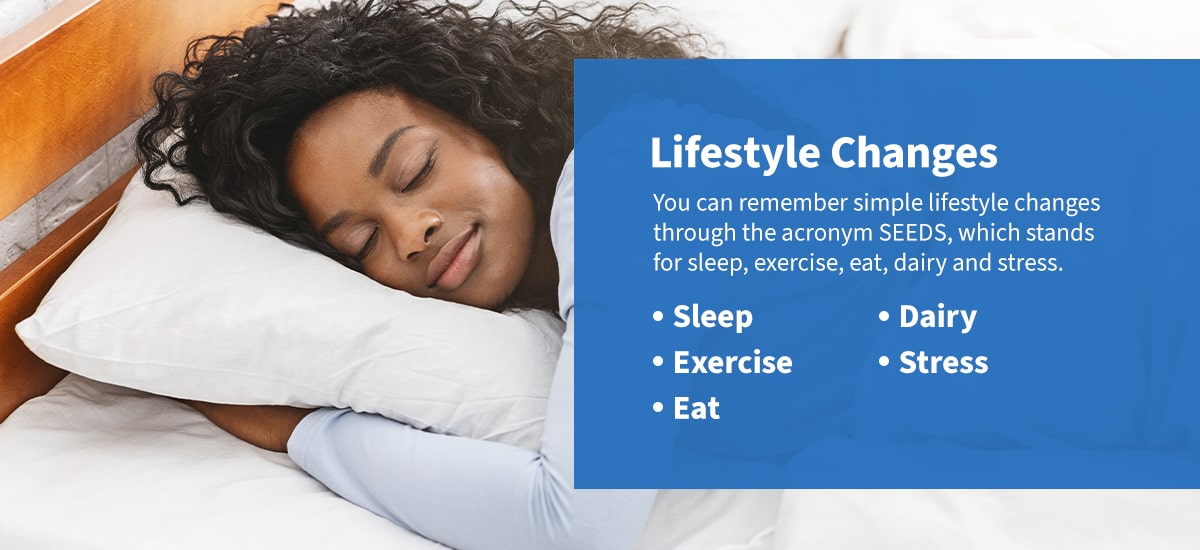Migraines are a common condition, affecting millions of Americans every year. Chronic or severe migraines can make focusing on your daily responsibilities difficult. While some migraines may develop seemingly out of nowhere, many things may trigger migraine attacks.
One way to help migraines is to understand the common headache triggers that may be causing or worsening your migraines. Once you identify the possible migraine triggers causing your headaches, you can avoid these triggers, minimizing the chance of headaches.
1. Stress
Stress is largely considered to be the most popular migraine trigger. There is a strong correlation between those with chronic migraines and high-stress levels. Additionally, stress can trigger tension-type headaches. If you are experiencing high levels of stress, you may notice more frequent or severe migraines.
Managing stress is essential to overall health. Proper diet, exercise and meditation can help you manage stress levels, potentially reducing the frequency or severity of migraines and tension headaches.
2. Diet
Diet plays a large role in your overall health and may also be a leading trigger for migraines. Common food migraine triggers include cheese, chocolate, artificial sweeteners and cured meats. Alcohol and caffeine can also cause or worsen migraines.
Research identifies a significant relationship between food and a headache, with fats, carbohydrates and proteins affecting the likelihood of developing a migraine. If you notice you develop a migraine after having a certain food or drink, you may want to limit or remove this food entirely from your diet.
3. Poor Sleep
Poor and unhealthy sleep habits are common triggers for migraines. Sleeping is a time for the body to rest and heal, including the brain. Without proper sleep, you may be more likely to experience more severe migraine episodes. Morning is one of the most common times for migraines to occur, as well.
Irregular sleep can cause migraines, including too little sleep and too much sleep. Correcting your sleep schedule and setting a sleep routine can minimize the frequency and severity of migraines. On average, adults between 18 to 60 years old need seven or more hours of sleep a night.
4. Dehydration
Dehydration is a common migraine trigger. Additionally, dehydration often worsens existing or underlying health conditions that cause or worsen migraines. If you experience chronic migraines, you should ensure you are drinking enough water each day — this amount depends on your unique characteristics, but many experts recommend eight to 10 glasses daily.
5. Lights and Sounds
Many people report bright lights or loud noises as a leading cause of migraines.
While natural light can cause migraines, many people experience migraines from flickering bulbs or strong fluorescent light, which can be difficult to avoid for those who work in an office or factory setting with bright lights. You may be more likely to experience a migraine from extremely loud or continuous sounds, such as a jackhammer, concert or loud movie.
If possible, you should minimize your exposure to overly bright lights or loud noises.
6. Spinal Misalignment
Spinal misalignment can also be a contributing factor to migraines. Spinal misalignment can cause migraines because of nerve compression and irritation. If spinal misalignment is causing your migraines, spinal realignment can correct the misalignment at its source.
7. Strong Scents
If you have a predisposition to migraines, smells may play a role in migraine headaches. Strong scents may trigger headaches or worsen a migraine if you already have one. Unfortunately, migraines triggered by odors are often more severe and may also cause nausea.
How to Cope With Migraine Triggers
Coping with migraines can be difficult, and many people look for migraine relief. Fortunately, there are many ways to minimize migraines and improve overall health.
If you experience chronic headaches, you may want to consider these tips to manage migraine triggers and find relief:
Lifestyle Changes
Fortunately, because many migraine triggers result from daily activities, you can make lifestyle changes to minimize the frequency and severity of migraines. You can remember simple lifestyle changes through the acronym SEEDS, which stands for sleep, exercise, eat, dairy and stress.
- Sleep: A healthy sleep schedule is essential to minimizing migraines. If you experience frequent migraines, poor sleep may make these migraines worse. It may help to go to sleep and wake up at the same time every day.
- Exercise: If you have a migraine, you should avoid exercising because physical activity can worsen headache symptoms. When you don’t have one, exercise can be a useful tool to minimize the duration, severity and frequency of migraines.
- Eat: Your diet, including food and drink, also affect your overall health and migraines. It can help to ensure you eat balanced meals throughout the day, avoid fasting and remain hydrated. In general, you may want to limit soda and coffee intake, as caffeine often worsens migraines.
- Dairy: Inflammatory foods, including dairy, may cause or worsen migraine episodes. If you notice you experience more migraines after a meal with dairy, you may want to consider limiting your dairy intake or removing dairy from your diet entirely.
- Stress: Finally, making lifestyle changes to minimize stress and promote overall mental and emotional health may improve migraine symptoms. High or frequent episodes of stress can greatly increase your risk of a migraine or headache.
Upper Cervical Care
National Upper Cervical Chiropractic Association (NUCCA) is a painless form of spinal correction to alleviate pressure from the nervous system. NUCCA can return the pelvis, spine and skull to their original positions, ensuring proper alignment and overall spinal health.
A versatile treatment, NUCCA can even help improve chronic migraines. Because NUCCA alleviates nerve pressure, the spine and body can return to their natural, healthy state. During a NUCCA treatment, physicians gently adjust the Atlas vertebra, or the spinal bone, to its proper position.
Poor or unhealthy spinal alignment and vertebra health may cause or worsen migraine episodes and symptoms. NUCCA can correct poor spinal health at its source, minimizing the frequency, duration and severity of migraines.
Find Lasting Relief With UCC-NY
At Upper Cervical Chiropractic of New York, we are dedicated to restoring the health of our patients whose nervous systems may be worsened by a condition known as a subluxation complex. We offer the most effective and safest spinal correction procedures available.
NUCCA is a versatile treatment that can improve symptoms of various medical conditions, including carpal tunnel syndrome, back pain, herniated discs and scoliosis. Our team promotes a lifestyle of wellness in a comfortable, compassionate atmosphere.
Contact us to learn more about NUCCA and spinal alignment.
REVIEWED BY DR. GEORGE GERTNER

Dr. George Gertner is a family man, healer, philanthropist, author of “The Gift of Hope”, public speaker, and founder of one of the world’s busiest Upper Cervical Chiropractic clinics.
After receiving his bachelors degree in biology from Hofstra University in Hempstead, NY Dr. Gertner moved to Atlanta, GA to attend Life University. Before graduation, Dr. Gertner had a severe injury to his lower back. Traditional chiropractic procedures were not providing relief until he met a chiropractor that specialized in NUCCA (National Upper Cervical Chiropractic Association.)
Then he spent the next two years mentoring from one of the best Upper Cervical doctors; learning in the same office that helped change his life. After two years, Dr. Gertner returned home to New York to open his own office. He currently is one of less than 300 NUCCA chiropractors worldwide.
Dr. Gertner has been featured numerous times in Chiropractic Monthly Magazine for his expertise in treating Trigeminal Neuralgia and Myofascial Pain. Dr. Gertner has lectured locally and nationwide discussing various symptoms using the Upper Cervical technique.




